PRASHANTI DIARY
CHRONICLES OF HEAVEN ON EARTh
'Pushpanjali' - Programme by Students of Sri Sathya Sai
Deena Janodharana Pathakam, Andhra Pradesh - March 3, 2007
 |
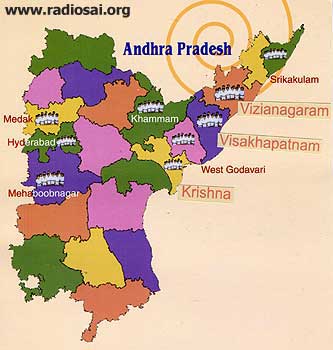
|
| |
The districts in Andhra Pradesh where Sai Orphanages exist |
“Go to the help of the poor and the forlorn. Real service is seeing the almighty in the poor and the destitute,” Swami says. True to this dictum Bhagavan Sri Sathya Sai Baba started the Deenajanodharana Pathakam in Puttaparthi in the year 2000.
Under this scheme Swami has provided free shelter, food, education and medical care for the unfortunate children who lost their parents when they were little ones. They are now being groomed into ideal human beings. [In an earlier issue, we had a cover story on this project, click here to read that story again.]
With the inspiration given by Swami and taking it as Swami’s divine command the Sri Sathya Sai Deena Janodharana Pathakam was started in the Khammam district of Andhra Pradesh with merely seven children.
Gradually the scheme spread to nine districts of Andhra Pradesh; viz. Arasavalli in Srikakulam district, Lakshmipuram in Vizianagaram district, Tanuku in West Godavari district, Khammam and Kothagudam in Khammam district, Vangal in Medak district, Kalvakunti and Vanaparthi in Mahaboobnagar district, Sarornagar in Hyderabad district and Vijayawada in Krishna district. In all, 100 children benefit from this scheme.
This project is executed in a planned way beginning with the selection of the students right up to their employment. The children are selected on the following basis:
- The child does not have parents, or, if the mother is unemployed and does not have enough financial resources to support themselves.
- The child should be between the age group of six to thirteen years.
- The child should have interest in studies.
- The child should be in sound health.
They are brought to the Sai centres where an examination is conducted to discern how good the child is in studies. Based on the result the child is put in the English medium school.
The Deena Janodharna Pathakams in Different Districts of Andhra Pradesh
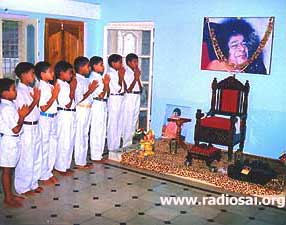 |
 |
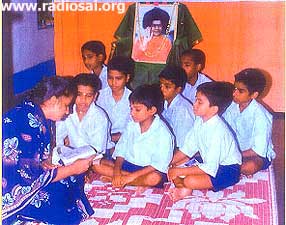
|
Adopted children in Khammam District |
|
Teaching them values in West Godavari District |
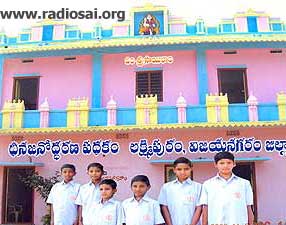 |
 |

|
The beautiful building and boys of Vizianagram |
|
This one is in Mahaboobnagar |
|
Once the student joins the Deenajanodharana Pathakam, he becomes a member of this Sai family. He now has to follow the rules and the daily routine set for every student. The daily routine caters to the student’s all-round development and personality development.
The daily routine:
5:30 am - 6:00 am Omkar, Suprabhatam and Nagarsankeertan
6:00 am – 6:15 am Physical exercise
6:15 am – 7:45 am Breakfast
8:00 am – 1:40 pm School
1:45 pm – 2:15 pm Lunch
2:15 pm – 3:30 pm Rest
3:30 pm – 4:00 pm Milk and Snacks
4:00 pm – 5:00 pm Outdoor Games
5:15 pm – 5:45 pm Bhajans and Bal Vikas
6:00 pm – 7:30 pm Study hours
7:45 pm – 8:15 pm Dinner
8:20 pm – 8:30 pm Prayer and Milk
8:30 pm – 5:00 am Bedtime
One of the teachers of the Deenajanodharana Pathakam remarks, “This daily routine has helped the students imbibe strict discipline and punctuality in their lives. All efforts are made to ensure to provide good physical and mental health to these students.”
It is not only the physical and mental health that is addressed but the emotional well-being is also taken care of since most of the students are orphans. Therefore, during festivals like Sankrati, Diwali and others, these children are invited to the houses of Sai devotees to participate in the celebrations along with the children in the family. This makes them realize that they have kith and kin who love them and care for them.
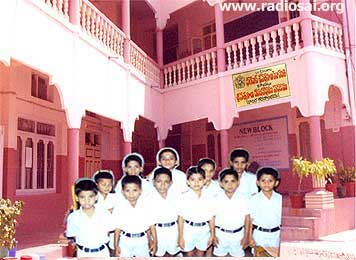 |
 |

|
These boys now have a nice home in Vishakapatnam |
|
The 'temple for living' in Srikakulam |
In addition to achieving excellence in education, the teachers take upon themselves the responsibility to inculcate human values of Sathya, Dharma, Shanti, Prema and Ahimsa in the students. This is done by telling them stories that reflect Indian culture and spirituality. The students here participate in service activities, learn fine arts like music, painting and dance, chant Vedic hymns, thus shaping themselves into ideal citizens of India. In the words of a teacher, “They are groomed to become ideal citizens by doing selfless service so that they can become ideal instruments and worthy citizens of India.”
On March 3, 2007, these children presented a “Pushpanjali” – a bouquet of programmes in the Divine presence which included a band performance, Veda chanting, traditional Pandhari bhajans, a speech about their experience in the Deenajanodharana Pathakam and a musical dance drama entitled “Jagruti”, meaning “Awakening”.
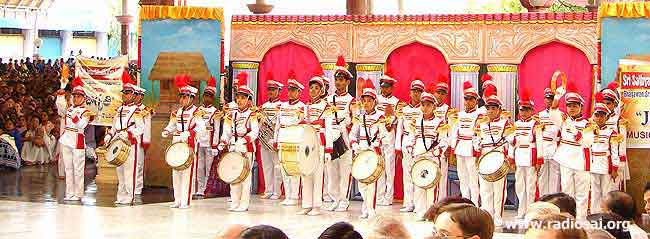 |
The band of boys from Sai Orphanages present a commendable performance |
Sai Mani, a little one from Hyderabad gave a moving speech in the divine presence. He spoke about the divine love that all the boys at Deenajanodharana Pathakam enjoyed under the divine umbrella. Pouring his heart out, he said, “When God Himself is our mother and father we need not worry about our future. We pledge that we would carry the message of love that Baba preaches and thus become His worthy instruments.”
 |
 |
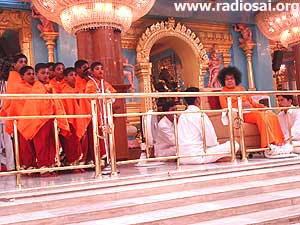
|
His eloquence and liveliness stole everyone's hearts... |
|
They chant vedam too, skillfully |
Then came the Vedam chanting. Dressed in Angavastram and dhoti (traditional dress worn by Veda pandits), students from the Deenajanodharana Pathakam of Vishakhapatnam chanted the Narayana Suktham in the immediate presence of the Vedapurusha Himself. Bhagavan listened intently to the boys’ chanting.
This was followed by the boys from Srikakulam district presenting a colourful Pandhari bhajan. Boys dressed in traditional attire danced to the beat in perfect coordination.
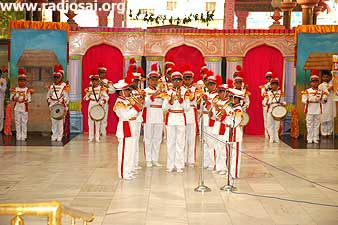 |
 |
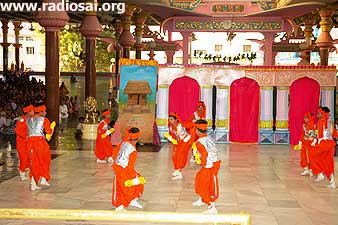
|
The band boys had a 'band of items' to offer |
|
The chakka Bhajan was rythmic and riveting |
Now came the highlight of the evening’s proceedings – a musical dance drama entitled “Jagruti.” The drama depicted how an orphan by the name Sathyam, groomed in the Sri Sathya Sai Deenajanodharana Pathakam transforms a wealthy person, Mr. Jagannadhan, whose sole aim in life is to amass money and enjoy princely comfort, into one promised to carry out service to humanity under the divine guidance of Baba. The story goes thus:
Jagannadhan’s son Srichakri is a dancer of great repute. He encourages his son to stage a dance performance in America so that he can earn more money. Naresh, a friend of Srichakri also plans to settle in America. He too supports Jagannadhan’s view of going to America. Srichakri starts day-dreaming about the luxurious life of America. Just then, Sathyam, a close friend of Srichakri enters. Sathyam advises Srichakri that the purpose of education is to develop good character, devotion and discipline, not earning money. Sathyam then goes on to narrate stories of the great saint poet, Pothana who resented kingly honor and dedicated his immortal composition ‘Bhagavatha’ to Lord Rama Himself.
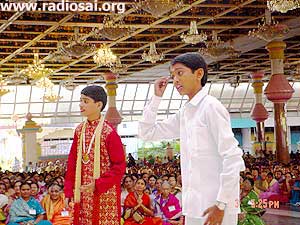 |
 |

|
Sathyam enlightens Srichakri on purpose of education and the sacred Indian culture |
|
The poet-saint Pothana who chose Rama
over wealth and fame |
Next, he reminds Srichakri about the glorious story of the great devotee Meera. She gave up all the princely comforts of the palace and spent her entire life totally immersed in Krishna. So deep-rooted was her devotion that when poison was given to her it turned into nectar.
 |
 |

|
Meera - the epitome of devotion and surrender
|
|
Dokka Seethamma - her heart bled for the poor |
Next Sathyam tells Srichakri of the inspiring story of Dokka Seethamma and her husband who jumped at every opportunity to serve the hungry. Once when the river was in flood and many people lay stranded without food and shelter, they went to serve the flood victims least bothered that they would lose their lives.
After hearing these exhilarating and exciting stories of sacrifice, service and devotion, Srichakri gets convinced that he too should walk the path of selfless service and devotion to God. But Jagannadhan seems to oppose Sathyam’s views. He only desires that Srichakri should earn lots of money and have a comfortable life full of modern amenities. He doesn’t want Sathyam to give “wrong advice” to Srichakri.
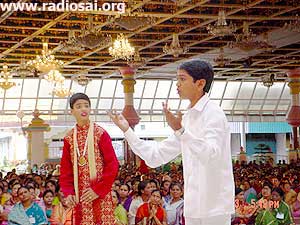 |
 |

|
"Listen to the call of our glorious culture" - Sathyam |
|
Jagannadhan disapproves Sathyam's sound advice |
At this juncture, the drama takes an interesting turn in the form of Jagannadhan’s old parents entering the stage. It is Sathyam who brings them from a destitute home where Jagannadhan had put them in his greed for money. Jagannadhan is put to shame when Sathyam challenges him as to what he would do if Srichari renders the same treatment to him. Jagannadhan bows and begs his pardon. Then Sathyam advices them to follow the path of love and devotion preached by Bhagavan, which they willingly agree to do.
 |
 |

|
The turning point - the entry of Jagannadhan's parents |
|
Srichakri is awakened and happy |
When asked how he got such noble thoughts, Sathyam tells them his story. He recalls the days when he was an orphan and had no one to support him, when an angel came to him in the form of the Deenajanodharana Pathakam. They treated him with complete love and care. “That day”, Sathyam says, “Baba became my mother and father.” That day onwards Sathyam realized that friendship means sharing love and not merely enjoying entertainment.
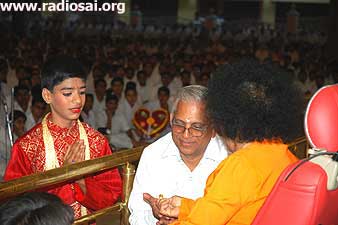 |
 |
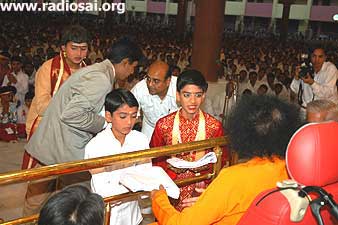
|
Swami blesses the playwright with a ring |
|
Eachone gets singular opportunity with Bhagavan |
The drama was full of powerful dialogues, melodious songs and beautiful dances. Moved by the performance, Bhagavan Baba called the playwright Mr. M.S. Prakasa Rao and blessed him with a shining emerald ring. He also gave Rs. 10000/- to get a printed version of the drama and instructed that the drama be staged in every town and every village of Andhra Pradesh to inculcate human values. Then He called each participant and gave them the chance to touch His feet and pose for a photo along with Him.
 |
 |

|
The Ganesha that the All-knowing One gave to Vivek |
|
Gifts galore for His children |
Bhagavan lovingly also gifted clothes to all the 150 students personally. For all the hitherto orphans who have now become proud children of their divine mother, it was a ‘triple blessing’. It was the moment of their life. So overcome with joy and gratitude they were that most of them were literally crying as they basked in His love. Sri Vivek, one of the students, was taken by surprise when Swami materialized a silver Ganesha idol and gifted it to him saying, “Do vibhuti abhisheka to the idol and eat the vibhuti everyday and your concentration will improve.” Only later Vivek revealed that he was having trouble concentrating on his studies. Truly, the students were extremely to be in the presence of their Mother who knew their problems even without their expressing it and blessed them profusely with remedies and reassurances.
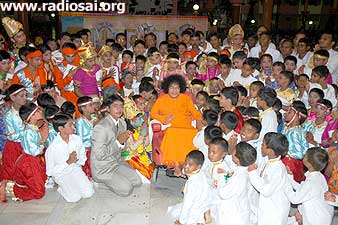 |
 |
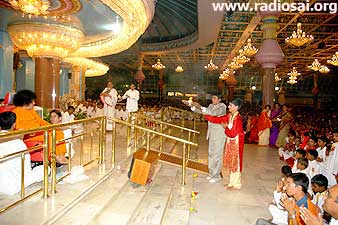
|
All the children with their Divine mother and father |
|
The beautiful evening comes to an end |
Later, speaking to the office bearers of the organization, Bhagavan expressed that such Sri Sathya Sai Deenajanodharana Pathakams be established in all the districts in Andhra Pradesh.
The scintillating and brilliant performance came to an end when Arathi was offered to Bhagavan. It was past 6 in the evening.
Celebration of Holi in Prasanthi Nilayam: March 4, 2007
The Morning Programme
Colours! Colours of life, of joy, of happiness, sometimes of pain and disappointment. Life is a celebration - a celebration of these colours. In India, the festival of Holi, symbolizes this celebration. There are so many fascinating and interesting legends and stories associated with this festival. Holi gets us close to the glorious ancient past.
The colourful festival of Holi is celebrated under different names in this vast and culturally diverse country. The traditions followed for the festival varies somewhat from one state to another as one studies the various facets of the festival and understands the different cultural contexts. One region where it is celebrated with utmost gaiety and enthusiasm are in the places of Mathura, Vrindavan, Barsana and Nandgaon - which are all associated with the birth and childhood of Lord Krishna. At Barsana, Holi assumes the name of Lathmaar Holi.
| |
|
|
| |
Holi...a festival of colour and gaeity |
|
In Haryana, it is called Dulandi Holi, people of Maharashtra name it Rangapanchami, as Basant Utsav and Dol Purnima are the names in West Bengal. The fun-filled and enthusiastic people of Goa know Holi by the name of Shimgo in their local dialect Konkani, while the people of Tamil Nadu know Holi by three different names Kaman Pandigai, Kamavilas and Kama-Dahanam. Actually, the legend of Holi which is extremely popular in Southern India is that of Lord Shiva and Kaamadeva. According to the legend, people in the south celebrate the sacrifice of the Lord of Passion, Kaamadeva who risked his life to invoke Lord Shiva from meditation and save the world.
In Bihar, this festival of colors is known as Phagwa as it is celebrated in the later part of the month of Phalgun and the early part of Chaitra as per the Hindu calendar. This corresponds to the English months of March-April.
The celebration of Holi in Prasanthi Nilayam has gained momentum ever since the devotees from Bihar and Jharkhand thronged to Prasanthi Nilayam with their colourful and profound programmes three years ago. This year too, they brought along an enthralling cultural feast.
Bhagavan arrived at the aesthetically decorated Sai Kulwant Hall just before 9:00 a.m. Thousands of devoted souls joined the hundreds from the states of Bihar and Jharkand greeting Bhagavan on this holy ‘Holi’ day…Colourful balloons and hoardings with His Divine Messages were welcoming Bhagavan, metaphorically signifying the colourful nature of the festivity coupled with spiritual significance.
|
|
|
Invoking Lord Ganesha.... the first dance |
|
Dancing in the presence of Nataraja |
The first song, dedicated to Lord Ganesha, the remover of all obstacles, echoed that He is the embodiment of all auspiciousness. The devotees went on to sing that no worship can succeed unless the heart is pure and the senses are mastered. At this point, it is maybe worthwhile narrating how the legend of Holi actually began. It is a story which demonstrates the Lord's loving protection and care to a pure heart. Holi dates back to the time of the great little devotee and his Lord - Prahalada and Hiranyakshyapu. Hiranyakshyapu, the demon king (representative of the modern misguided scientific mind) considered himself a God and wanted everybody to worship him. To his great ire, his own son, Prahalada began to worship, Lord Vishnu. To get rid of his son, Hiranyakshyapu asked his sister, Holika to enter a blazing fire with Prahalada in her lap, as she had a boon to enter fire unscathed. Prahalada's great devotion saved him while the fire consumed Holika – she had paid a price for her sinister desire. The tradition of burning Holika or the 'Holika dahan' comes mainly from this legend. Coming back to 2007, and Parthi the entire song, depicted through a dance was a treat for the ears as well as the eyes.
|
|
Soon afterwards little dancers came singing, “Mother, you are the most beautiful! One may go to a hundred places in the world, but there is no one parallel to the mother and Her magnanimous heart.” Unity in Diversity was demonstrated imaginatively by the seven colours of rainbow, which merge to form one white colour.
After this song entitled “Vande Mataram”, the singers enchanted the audience with another song “Bal Leela” on the childhood pranks of Bhagavan. And then came a vibrant Qawali. Dressed in traditional attire, the Bal Vikas children danced to the beat as the Qawali singers pored their heart. |
| Singing the Bala Leelas of the young Sai |
|
|
‘O Lord Sai! Your doorstep is Kashi and Kaba.
Whoever develops kinship with You, receives everything.
May jealousy, greed and ego never crop up in our minds.
May we always drink the nectar by repeating the name of Sai.
May our devotion never diminish.’
|
|
|
Qawali was lively with rythmn and poignant with meaning |
These beautiful sentiments filled the air to the delight of the devotees.
It is a belief that Biraj or Brindavan, the land of Lord Krishna, is also the land that witnessed the first celebration of Holi. The singer captured this mood of Holi in Biraj where the gopis and gopikas played Holi with their beloved Krishna and then compared it with the Holi celebrations in Parthi. They sang, “There is rejoicing in Baba’s courtyard on this Holi day. Sai is the Lord of the universe and His courtyard is the place of liberation.”
The mood of Holi in Parthi was aptly reflected when they sang, “Parthi is drenched in Holi colors. This is a sacred festival in the month of Phalgun. Every year the devotees come here to play Holi and redeem their live by Sai’s darshan.”
Continuing on the same theme, the next song, “Krishna, Krishna, kahe ujadi meri neend”, meaning, “O Krishna, why did you disturb our sleep?” portrayed the sweet relationship between the Gopikas and Lord Krishna. The Gopikas represent the Jivatma (the individual soul) while Krishna symbolizes Paramatma (the cosmic self). The Paramatma awakens the Jivatma from its deep slumber of ignorance. When awakened, the Jivatma searches frantically for its master. It is only when the Paramatma reveals Himself, that the individual soul finds fulfillment and attains bliss. The singers sang this Divine Love that characterized the relationship between Gopikas and Krishna. In the song, the Gopikas ask Krishna, “Why have you disturbed our sleep?” But mischievous young Krishna plays His pranks with the Gopikas. He runs away and the Gopikas search for Him everywhere. But to their utter dismay all their search is in vain. All of a sudden Krishna appears before them and makes them blissful.
|
|
|
The Jivatma in its eternal quest of Paramatma - the Gopikas and Krishna Rasa leela |
The song was no doubt melodious, but beauty was added to it by the young dancers attired as Gopikas and Krishna. Their expressive faces and elegant movements made the whole scene come alive so enchantingly. One could not help but imagine the glorious days of Brindavan.
This was followed by a Bhangra - “Antar mein hain Antaryami”. The devotees of Bihar and Jharkhand made a commendable effort in depicting the most popular folk dance of Punjab – the Bhangra which is an integral part of the Punjabi culture. The dancers garbed in colorful customary dresses danced in full enthusiasm while the singers sang the Punjabi song reminding one and all that the All-knowing One, who is inside you is none other that the one sitting right in front of you, Bhagavan Baba. “Why do you wander from door to door when all the four dhams (spiritual destinations) are right here? Sai is Rama, Krishna, Jesus and Nanak.”
|
|
|
The Bhangra “Antar mein hain Antaryami” was vibrant |
The concluding Holi dance “Sang sang mil ke gao” meaning, “Lets all sing together” was an extremely colorful dance performance and a grand finale as the dancers threw gulal – red powder in the air while they danced and sang:
“O Kanhaiya let us hear the sweet music of Your flute.
The colorful Holi has come to the sacred land of Parthi.
Play Holi with us.
Eshwaramma’s beloved son has created a stir in the whole universe.
The nectar of love is flowing all through...
Everyone should engage themselves in Seva and rejoice at the Lotus Feet”.
Colorful, glorious and memorable – that’s what the Holi morning was.
|
|
|
Yellow, pink, red and green…the grand finale of the colorful morning |
Holi Evening Programme
The evening programme displayed another colour, quiet a contrast to the morning. If the morning programme enthused colour and gaiety, the evening programme was deep with profound meaning. The afternoon programme, a play titled ‘Man Darpan’ was a portrayal of this turbulent mind and its great vistas.
'Manaeva Manushyaanaam Kaaranam Bandha Mokshayoho’ is the saying from the Vedic scriptures. This means that mind alone is the cause for either bondage or liberation. Bhagavan often refers to this in His divine discourses. The mind alone has the power to make or break a person.
The drama, put up by the youth members of the SSSO, Bihar and Jharkhand conveyed this message very powerfully. The drama began with five friends who assemble to celebrate Holi and exchange notes, boasting their professional achievements. A common friend, Veda, misses the celebration with them. The next day all the six of them meet at Veda’s residence.
Veda narrates how he celebrated Holi at an Old Age Home and the satisfaction he derived out of the same. The other five friends consider it bizarre and express their surprise and dissatisfaction. Veda then says that true happiness can be found only within and will not be available outside. And to experience the same, one has to have control over the mind, which comes only from the control of the senses.
|
|
|
|
|
At the reunion of five friends... |
|
|
As Veda begins to explain the intricacies, the drama moves into an ancient setting with the character of Kal Charka (time) coming on to the stage. He sights examples from the various periods or yugas when great kings, and even seers and sages too fell in the same trap - the trap of the mind.
“In the Sathya yuga”, Kal Chakra says, “Great yogis used to undergo great tapas in order to control the sense and hence the mind. But the wavering mind would jump from one thought to another and make man dance to its tune. The yogis, through arduous penance would command the mind to be calm. The restless mind would retaliate trying to divert it from tapas. But the yogis who exercised total sense control eventually won this tumultuous battle between mind and man. Once their mind was calm, everlasting inner peace would manifest itself within them."
|
How the monkey mind torments... |
|
|
Kal Chakra goes on to narrate the Rama story from the Tretha Yuga, “Ravana a slave of lust and greed, abducts mother Sita and finally ruins not only his life but is responsible for the annihilation of his entire clan. Ravana, was no doubt a great tapasvi (man of severe penance), but a slave to his senses. He had no control on his mind. It was his uncontrolled mind that ruined him completely.”
He then tells the story of King Parikshit who lived in the Dwapara yuga. Parikshit was the grandson of the illustrious Pandavas. His father was Abhimanyu, Arjun's son. A great and righteous king, Parikshit looked after his subjects well. He was considered to be the personification of goodness and nobody could match him in valour. |
|
|
| |
|
Kal Chakra recalls the story of Rama... |
On one occasion when King Parikshit had gone on hunting, he went deep into the forest and became lost. As he was wandering in the woods alone looking for food he came across a sage (Sage Shameeka) in deep meditation. Parikshit, overcome by his intense hunger and fatigue, asked for some food and shelter. The sage, too lost in deep contemplation, did not answer and this made the great king livid and insulted. To avenge the ‘insult’ he picked up a dead snake and laid it on the shoulders of the sage. The sage had a son named Shringi. Upon hearing that the King had insulted his father while he was under a vow of silence, the enraged son cursed the King with death within seven days. Sage Shameek, his father, was not pleased to hear what his son had done, for he knew the reason behind the king’s action. He sent his most intelligent pupil, Gaurmukh to Parikshit to warn him of the impending danger and to protect himself in any way that he can. King Parikshit listened and accepted his fate without argument.
Parikshit, in his utter dismay questions his mind, “O Mind, why did you not stop me from putting a dead snake around the sage’s shoulders and neck? It is your entire fault because of which I have to suffer.”
|
|
|
King Parikshit uses a dead snake to insult the sage |
|
“O Mind, why did you not stop me?” – King Parikshit |
The mind then reminds Parikshit that he was not the one to be blamed but the onus lay with himself. Mind goes on to explain, “Overcome by fatigue and anger, you lost your power of discrimination and committed a heinous sin. Instead, had you any control on me and compassion in your heart, you wouldn’t have insulted the sage.”
The Mind is confused due to the reflection of both - virtues and vices. While virtues of love, compassion and benevolence pull the mind to walk the path of goodness, the vices in the form of lust, greed and jealousy drag the mind into the bottomless pit of evil. This turmoil of the mind forces it to seek the guidance of Wisdom. Wisdom advises the mind, “O Mind, Control the senses. Vices pulls the mind towards the other extreme…Selfless Service suffused with Unconditional Love is the only remedy to control the senses.”
|
|
|
The mind is torn between virtues and vices |
|
Mind listens to the advice of Wisdom |
The scene moves forward in time where Veda narrates these episodes to his five friends. Witnessing these scenes brings the essential transformation in them. Veda, the wise friend, declares that Bhagavan Sri Sathya Sai Baba as the best example of the spirit of selfless service in His message to mankind - “Only unconditional Love for God will purify the mind and Love is the ultimate solution for all the problems of the World.”
The Lord, pleased with their presentation came down from the dais to bless the participants with a group photograph. While He did so, Bhagavan also lovingly interacted with a few participants.
|
|
|
Unforgettable moments... |
|
Treasured for eternity |
Indeed, a marvelous Holi Day with a ‘holier’ message—the message of Unconditional Love. The Sai mission marches forward with His Message of Selfless Service and Unconditional Love.
'Gratitude Programme by II PG Students: March 17, 2007
February and March are months when students put up ‘Gratitude Programmes’ in the divine presence. As the name suggests, the theme of the programmes are to convey their heartfelt gratefulness to Swami for all that He has given them in their stay over the years at His lotus Feet. There are students who have been recipients of Swami’s education right from the class one upto their double post-graduation – nineteen years in the direct divine presence; while there are others with the privilege of being a ‘Sai Student’ for two, three, five, seven or more years. Now as they move out into the wide world to pursue their professional careers, this truly is a touching moment for most boys. They pour out their feelings to Swami recollecting all those blissful moments with the Lord which made all the difference to their lives.
This year too, the 2nd year post graduate students put up a colourful programme in front of Swami. Here is the report from one of the students who has completed nineteen years in Swami’s institution.
“Bhagawan says, ‘Love my uncertainty.’ This aspect of Bhagavan was made very evident as the senior boys tried in many ways to get approval to put up a program in the mandir, to express their gratitude to Bhagawan for His love. Group songs in different languages were learnt, some took to preparing a dance, a few of them prepared relay speeches to be delivered between the songs, the artistic among them took to make exquisite cards for Bhagavan requesting permission to put up the program, while some others went on to prepare skits.
But Bhagavan had different plans. He avoided all our approaches. The students persisted with different cards of invitation. Maybe, the right time hadn’t come. Our prayers were becoming stronger. That is what He wanted, perhaps. A week later Bhagavan asked for the program to be put for Ugadi (New Year). This was not what we had expected and we were thrilled. However, Ugadi too was not to be the day. We were beginning to get a little disheartened, but were sure that Swami would listen to our prayers. Just when we had reached the moment of despair, Bhagavan sent a message asking specifically for the program to be staged the following day.
|
|
|
Intimate moments before the performance |
|
Swami enquires about the make-up and the roles
|
On the evening of 17th March the program was held in the divine presence. The premeditated delay had only intensified the feelings of gratitude and love for Bhagavan. Prior to the program Bhagavan came to the Bhajan hall, where the students were getting ready with their makeup and costumes for the dances and skits. He interacted with the actors and dancers and displayed His eagerness to see the show.
|
|
|
A student offers his art at the lotus feet |
|
God’s love is sweeter than chocolates!! |
The gratitude programs are structured in such a manner that every student gets an opportunity to be close to Bhagavan with either a card, a rose, a candle, a tray of chocolates or some artwork. Bhagavan too lovingly blesses them by allowing them touch His Feet, speaking to them, and by accepting their offering of love. So, during the program all the students had the unique opportunity of going to Bhagavan. Some of them had the songs written down beautifully in the form of a card, a few others took trays of chocolates and pens to be blessed. There were others who took their paintings and sketches to get them blessed. One of the cards was in the shape of a heart with another heart within it, linked by a chain.
|
|
|
| Bhagavan blesses a tray full of pens |
|
The bond of love binds every heart to His heart
|
|
|
Bhagavan asked what it was for and the student went on to explain that ‘The big heart’ signified Bhagavan and ‘the smaller one’ signified the students. The students are always in Bhagavan’s heart and they are linked by the bond of love. Bhagavan was very much moved. He accepted the card very lovingly and kept it with Him for the entire program.
During the program, we sang many songs learnt specially for the occasion. Before every song a few students would get up, take the mikes and express their gratitude to Bhagavan, in their mother tongues, for all His love and grace. It was a heartfelt outpouring of love between a mother and her children. The students from the band group too put up a special performance.
|
Every student has a unique experience |
|
|
Adding drama to the whole episode, was a pot breaking ceremony enacted wherein little Krishna with the assistance of Gopalas gets down a pot of butter. This event was to signify how Sai Krishna has gathered His own Gopalas around Him to share His love amongst them. Then there was the dance program put up by amateur dancers from among the students. Bhagavan seemed to enjoy every moment of the dance as He watched the dancers intently.
In the last lap of the programme, there were two skits staged by the students. The first was on an incident from the life of Adi Sankara. It was a skit in Hindi depicting the incident of the great saint meeting the Chandala (low caste). The Chandala imparts wisdom to the learned saint teaching him that the indweller in all beings is one and the same.
|
|
|
|
|
Gopalas reaching for the Pot |
The second skit was a one-act comedy in Telugu. The story went like this: There has been theft in the heavens above. Lord Brahma has lost his lotus and the mountain Meru. The moon has been stolen away from the skies. The lord of fire, Agni, is missing. The Dunnapota (buffalo) of Lord Yama is missing. The clouds of Lord Indra are missing.
|
|
|
Lord Shiva come in the form of chandala |
|
Chandala imparts wisdom to Adi shankara |
Finally Lord Shiva and Mother Parvathi are missing. The gods are agitated and pray to Lord Vishnu for help. He appears before them and becalms them. He explains to them that Lord Shiva and Mother Parvathi have taken birth as the Shiva Shakthi Swaroopa, the avathar of the Kali age, Bhagavan Sri Sathya Sai Baba. His eyes are like Brahma’s lotus, Mt Meru is the mole on his cheek, His countenance is the moon, the curly locks upon His head are the clouds of Lord Indra and His apparel is fire.
|
|
|
A scene from the Telugu skit |
|
The Lord interacts with the actors |
There was thunderous applause for the entire program. Bhagavan was too touched by the effect that the drama created. Every student had His personal moment with God. As if this were not enough, Bhagavan called for group photographs with different groups and made one student even announce the name of the group as each group came forward and took a photograph with Him. There was only joy and love all around and the feeling of separation melted away. Bhagavan made the day for the students and filled them with confidence and courage to face the world for which He had prepared them for.”
|
|
|
The divine teacher with His students |
|
……building confidence and courage in them. |
Burra Katha Presentation by Institute Students: March 18, 2007
March 18th presented to the students of the Sri Sathya Sai University a unique chance to perform a Burrakatha in the presence of their Lord. Many might not know that Burrakath is actually one of the prominent folk art forms and probably the most popular form of narrative entertainment in Andhra Pradesh. One can say that it is the Telugu art of story telling. In this theatrical form, a storyteller accompanied by his partner gives recitals for two or three days. He sings, dances and recites a story before the village folk under the patronage of a village elder.
|
|
The term 'burra' refers to 'tambura', a stringed instrument worn across the right shoulder of the performer. 'Katha' means a story. Thus ‘this story-telling accompanied with classical instruments’ requires lot of oratory as well as musical expertise.
The main performer (kathakudu) plays the tambura as he dances rhythmically wearing andelu (anklets) on the stage while reciting a story. He also wears over his right thumb, a hollow ring in the palm of his hand. With the rings, he beats the basic tempo of the songs.
At regular intervals during the narration, he responds to his co-performers, two drummers who play two-headed earthen drums (dakki) which are regarded as an indispensable ingredient of Burrakatha performances because of the distinctly metallic sound they produce. The drummer to the right of the performer is known as the 'rajkiya'.
He usually comments on contemporary political and social issues even if the story concerns historical or mythological events. The drummer on his left, the 'hasyam', cracks jokes and provides comic relief. |
The kathakudu renders soulful songs |
|
|
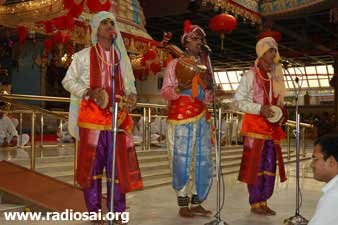
|
|
Bhagavan who persistently encourages the youth to always remember the rich culture and tradition of this ancient India was pleased to witness the students present this folk art. It gave Him immense joy when He saw three students of the Sri Sathya Sai University donned up in the traditional attire of Kathkudu, Rajakiya and Hasyam and get on stage to present a burrakatha entitiled “Devudamma Easwaramma”, that is, “Easwaramma – The Mother of God.”
The students began the performance with devotional songs in praise of Lord Ganesha and other celestial beings. Then, the kathakudu introduced the main story to the audience. He extolled Mother Easwaramma and narrated the story of the birth of this great soul who is today fondly remembered as “The Mother of God.”
|
| The indispensable drummers, ‘Rajakiya’ and ‘Hasyam’ |
|
|
As the main story began, all three performers took an active role assuming various characters in the incidents, as well as providing narrative bridges between incidents. They introduced various characters like Karnam Subamma (Bhagavan’s foster mother) and Pedda Venkappa Raju (Bhagavan’s father) amongst others.
The Rajakiya made one and all travel as if in a time machine to the olden days; the days when one had to travel miles and miles in search of drinking water, the days when Puttaparthi fell short of providing adequate medical facilities.
Those were the days when little children had to traverse long distances to attend school. He then reminded that it was mother Easwaramma who lifted up the ‘standard of living’ of the inhabitants of this tiny hamlet by virtue of the three boons she asked from Swami.
The excellent narrator compared each of the boons to Saraswati, Lakshmi and Ganga. He said, |
|
|
| |
|
Rajakiya narrates the story of Easwaramma |
“Bramha, the creator has Mother Saraswati as His constant companion. She is the repository of all knowledge. That is the reason Mother Easwaramma asked Swami to build a school. Secondly, Mother Lakshmi, the consort of Lord Vishnu, not only gifts man with the wealth of the world but also heals him of all his afflictions and diseases. It for this reason that Mother Easwaramma asked Swami to construct a hospital for the people of Puttaparthi. Finally, she beckons Swami to bless the land of Parthi with ‘Sai Ganga’ in the form of pure drinking water because it is Mother Ganga who resides in the matted hair of Lord Shiva and blesses mankind with her nectarous flow.”
Listening to this beautiful narration extolling Easwaramma, the embodiment of motherhood, Bhagavan was moved. He was so involved in the katha that one could feel as if She was right there standing beside Him. It was as if the tape was ‘rewinded’ and ‘played’ all over again much to the delight of the Lord Himself.
The Kathkudu went on narrating the story in many scintillating Telugu songs. One of them was –
“Enta goppa enthi vamma sadhivo Easwaramma
Evuru saateleru neeku jagatilo devudamma
Adigatey ambarani dinchada mungita nee sutudu
Adagakani echhuvadu asalaina devudu
Ambaram naaku oddu sambaram naaku oddu
Urivarikosamey ashta aishwarya”
which means…
“O mother Easwaramma, on this Earth you are the greatest amongst women.
O mother of God, on the Earth none equal you.
Had you asked your son, He would have brought the sky to your doorstep.
The true God is the one who grants without our asking.
But Easwaramma says, ‘Neither do I desire for the sky nor for any happiness and joy.
This Ashta aishwarya (in the form of schools, institutes, hospitals and water supply projects)
Is not for me, but for the sake of all the residents of Puttaparthi.’”
|
|
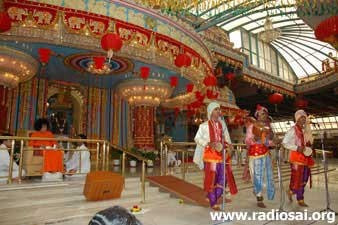 |
| The Lord recollects the fond memories from the past |
|
Singing the glory of God’s mother in the presence of God!!! |
While the kathakudu, an excellent singer, takes the audience through the events by the medium of songs and the Rajakiya narrates significant events, the Hasyam through his wit and humor brings smiles on all faces and enlivens the atmosphere. It was the time when the Rajakiya was narrating about Bhagavan being born in the month of Kartika (November - December) on a Monday, the Hasyam very innocently questions him, “On which day were you born?” The Rajakiya replies, “Well, it was a Sunday.”
A very astonished Hasyam refuses to accept the answer, but the Rajakiya keeps insisting, “No. No. It is the truth. I was born on a Sunday.” Finally, much to the amusement of the audience, the Hasyam goes on to say, “How can you be born on a Sunday when all the schools, colleges, banks, shops and even hospitals are closed. It is a public holiday, isn’t it?” The assembled devotees burst into laughter.
The story moved on listing significant events in the life of Mother Easwaramma. They cited instances of how anxious she became when Swami traveled to different places away from Puttaparthi.
The burrakatha came to an end in the form of a prayer to the Mother herself to come amidst us once again to witness the metamorphosis that Puttaparthi has undergone.
The Kathakudu sang (in Telugu):
“Okka saari marala nuvvu puttavamma Easwaramma
Nuvvu kalaluganna parthi entha maaripoyindo choodavamma
Apudepudo Swami neeku maatichchenu gurthunda
Puttaparthi maro Thirupathi avuthundani kada
Ghana parapathi perigenu mari Thirupathi kanna
Varanasini minchenu Shirdini maripinchenu.”
which means…
"O Mother Easwaramma, take birth once again,
See the magnificent transformation Puttaparthi has undergone.
Do you recall the promise that Swami gave you long ago;
Wasn’t it that Puttaparthi will become one more Tirupathi?
But today Puttaparthi has risen far beyond Tirupathi.
O mother! It has surpassed Varanasi and makes us forget Shirdi.” |
|
|
| |
|
“I was born on a Sunday!” - Hasyam |
The story of Rama would not have been possible without the presence of mother Kausalya. The glorious leelas of Gokul have become immortal because of the childlike pranks that Krishna played with mother Yashoda. In the ranks of such immensely fortunate women stands ‘Easwaramma – The Chosen One’. Fortunate was humanity to have a woman of this caliber born on Earth and more fortunate were the students who were blessed with this unique opportunity to sing her glory in the presence of her darling son.
Bhagavan blessed the boys with Padanamskar and fondly interacted with them after their performance. Later bhajans started and Bhagavan continued to sit in the Sai Kulwant hall itself instead of going to the bhajan hall, as is the usual practice. Indeed, it was a blessing for all devotees for they could sing His glory and simultaneously see His sweet form. Bhagavan then received arathi and proceeded for Yajur Mandiram leaving very sweet memories in the hearts of every student and devotee present.
|
|
|
Memorable moments with Bhagavan |
|
Bountiful blessings |
Ugadi Celebration in the Divine Presence: March 20, 2007
The Morning Programme
Bharat, is a land of varied cultures, languages, traditions and customs, and even varied new year celebrations. Blending this diversity into a quintessential oneness with the magical formula of Love bestows upon Prasanthi Nilayam the exalted status of being the epicenter of world spirituality. The miniscule amount of the world's population that throng to this privileged township share their cultural heritage and ignore any differences, turning the ashram into a home of harmony. This unique feature makes all the festivals shine with a unique glory in Prasanthi Nilayam. And within this spirit of unity and inclusivity come the different New Year’s celebrations that Bhagavan graciously permits to be held … differently styled and tailored to diverse mythical concepts and beliefs.
| |
|
|
| |
The richly decorated Sai Kulwant Hall on Ugadi morning |
|
March 20, 2007 marked the 'coming' of the New Year based on the southern Indian lunar calendar for three Indian states. It is Ugadi, the Telugu and Kannada New Year for Andhra Pradesh and Karnataka respectively. And in Maharashtra, it is celebrated as Gudipadava. Ugadi, an ancient festival that revels, in essence, by purifying the heart is a periodical reminder to man to revert to the age old godly path with righteous living. Bhagavan says: “The true celebration of Ugadi lies in giving up evil qualities and purifying one’s heart. The human heart in its pristine state is highly sacred and human birth is difficult to attain. External cleanliness, an observance that man does as a part of this festivity by getting up early in the morning, having a sacred bath, donning new clothes, etc. does indeed signify in essence the much needed inner purification that man should aim to achieve.”
Ugadi…the New Year of remarkable metaphorical significance, heralding auspiciousness and prosperity was celebrated with gaiety, piety and religious fervor in Prasanthi Nilayam in the Divine Presence of Bhagavan on March 20, 2007. A tastefully decorated Sai Kulwant Hall, bedecked with a blend of multi-hued flowers and festoons bore testimony to the grandeur of the occasion and the arrival of a much promising New Year. And it was that promising feature of this New Year, christened Sarvajith that caught the limelight on this most auspicious morning.
This Ugadi was extra special as Bhagvan had a twinkle in His eye as He came out for Darshan at about 8:40 am. The divine discourse that followed soon after His arrival made us realize the reason for that twinkle. Dwelling upon in detail on this ‘impending’ New Year, Sarvajith by name, Bhagavan, much to the delight of the thousands gathered in Prasanthi Nilayam declared the conferred boon, that the New Year would be a promising one that could fulfill all of humanity's ambitions and aspirations. He further added that one should develop right thoughts and with good thoughts one is bound to be successful. Ugadi has always been special for all Sai devotees as Swami has very often made declarations about the coming year. (more of this later!)
Bhagavan’s discourse was preceded by Prof. Anil Kumar. Ordained by Bhagavan to share his thoughts on the festive occasion, Prof Anil Kumar was at his poetic best recapitulating the immortal lines coined by Mahakavi Devulapalli Krishasasthri Garu. Recalling those immortal poems on the Love between God and a devotee, Prof. Anil Kumar emphasized, “Bhagavan is the Magnet…If there is any magnet that attracts devotees from all over the world, it is Bhagavan…” Every incident he shared was received with rapturous applause by the concourse of devotees assembled.
Speaking on the greater significance of the festivity, he recounted a memorable Ugadi morning in Brindavan in the year 1989, when the then President of India, Shankar Dayal Sharma was commanded by Bhagavan to address the gathering of devotees. He begged Bhagavan with utmost simplicity and sincerity, “I have not come to give a speech, rather I am here to listen to Bhagavan, and have His Divine Darshan with the belief that all auspicious things on that doubly auspicious Ugadi day would repeat manifold throughout the year.” The president who was requested to sit on a chair chose to sit at His Lotus Feet and even refused to accept a garland that was offered to him. Instead, he went on plucking petals from the flowers in the garland and offered them at Bhagavan’s Lotus Feet. |
|
|
| |
|
Prof. Anil Kumar presenting his poems |
Prof. Anil Kumar concluded his rhetoric excellence expressing gratitude on a personal note, narrating how Bhagavan’s Love and Grace has conferred his aged mother a peaceful end, remembering the Beloved One in her last moments and ultimately reaching the Divine Lotus Feet.
Prof. G. Venkataraman, who spoke next, said, “Among the various regionally celebrated New Years of Indian tradition, Ugadi is different as is evident from the very name itself.”
|
|
Talking on the Mobile Dispensary that is completing a year of yeomen service, Prof. Venkataram was lavish at praising the entire team of doctors and paramedics who have been actively engaged in rendering medical service to the poor village folk in selected areas of Anantapur District.
Switching over to the Drinking Water Project for East and West Godavari, Prof. Venkataram, who had been there personally to study the project activities, narrated the thrilling experiences and encounters he had during his visit. Referring to an incident wherein a tribal lady had donated an acre of land for the water project, and another incident where village women expressed their contentment and gratitude to Bhagavan for the boon of elixir divine, he said, he was astonished to find such fine qualities in ordinary village folks, that is surprisingly and unfortunately missing in the educated urban class. |
| Prof. G. Venkataraman shares his thoughts with the audience |
|
|
Talking about the role of youth in carrying Bhagavan’s Mission, he added, “The soul of India finds expression through the youth. Victory is here; Krishna is here and we are all Arjunas…by obeying His Divine Command the whole world can become a better one…”
During the Ugadi celebrations in the year 1985, Prof. Kasturi in his short speech in the Divine Presence significantly had mentioned that the New Year day was an occasion for devotees to draw up a balance sheet of their record during the past year and submit it to the Lord. “All of us”, he said, “are pilgrims to His Lotus Feet.” Man should cease to be blind any more and look up to the bestower with gratitude and in essence he should come to term with the reality that he is being constantly guided and guarded by the Supreme Selfless One. “You cannot indulge in sinful deeds and hope to realise the fruits of meritorious actions. Hence embark on good deeds and sanctify your life.
Do not get needlessly agitated over the name of the year. Shed all fear and, placing your faith in God, transform even a dreadful year into a divine one.” Bhagavan had urged the gathering in the 1985 Ugadi message in Prasanthi Nilayam. |
|
|
| |
Now coming to the main part of the 2007 Ugadi celebration. Bhagavan rose for the discourse holding on to the brass handle in front of Him and refused to use the customary table. It was evident that Swami had something urgent to tell and did not even wait for the microphone. The discourse began with reeling out the names of coming years. Prof. Anil Kumar (the translator) was just not able to keep pace with Swami. Then Swami declared, “Divinity is always born in the Akshaya (name of the year) year. This body too was born in the Akshaya year. This body has seen two Akshaya years.”
|
|
Swami went on to tell the special significance of this year named ‘Sarvajit’. He declared that this would be one of victories. “Any endeavour taken up this year whole heartedly will result in its successful fruition. Therefore, in this year, Sarvajit, strive to realise the divinity latent in humanity. The year Sarvajit fulfils such desires which are truthful. The year will see significant progress being made in the moral, physical, righteous, spiritual and scientific fields. A truthful desire will always result in fulfillment. One has, however, to hold on to the Truth with steadfast faith. Sarvajit year will bring victory in all possible ways. It is the most important year in all these sixty years. ‘Jit’ signifies victory. Sarvajit means victory in all fields of human endeavour. If one were to progress in life, one has to cultivate truthful desires in this Sarvajit year. I have not seen a single person who cultivated such truthful desires and failed in his life. Hence, I exhort you all to cultivate truthful desires and aspirations and lead a life full of happiness and bliss in this Sarvajit year.”
Bhagavan, then, went on to chart out the mission for this year. “On this holy occasion of Ugadi, we are launching a new scheme for rural development, under the name, “Village Works”. It is necessary that every house in every village shall be kept clean. The houses are to be kept neat and clean both inside and outside.The children in these homes are also to be groomed into clean and healthy children. We propose to cover every village under this scheme. Of course, the project involves huge expenditure. |
| Bhagavan launches His new project “Village works” |
|
|
But, we don’t hesitate to incur the necessary expenditure. Money comes and goes. But, the help and good work we render remain. Hence, we must undertake this rural development project immediately. We are launching this scheme from today itself on the holy occasion of Ugadi. Every village must become a model and self-sufficient one. Only when the villages prosper, will the country prosper.”
He exhorted the youth to take up this ‘Village Works’ across the state and country. “Whatever you need, ask Me; I will provide. I am the ocean. Like the rivers that flow merge into the sea ultimately, whatever Seva you do to anyone, reaches Me only. Hence, don’t fear for anything. Why fear, when I am here? Do not hesitate to ask Me for whatever you may need. Surely, I will provide everything to you. Hence, make yourself ready to participate in this service, both men and women.”
At this point, Prof. Anil Kumar translated a sentence like ‘every village must become like a town’, to which Swami immediately retorted saying, “Not towns! Towns are dirty. From today onwards, you must all embark on a mission to bring about a transformation in the villages. It does not mean that the villages are to be transformed into towns and cities. In fact, I don’t like such transformation. First and foremost, the villages are to be kept clean. Already, the towns and cities are stinking with filth.
The people living there wear a neat pant, shirt and a neck-tie. But, their inner feelings are all bad. You must cultivate good thoughts and feelings, in keeping with the neat dress you wear. First of all, you try to bring about a transformation in your own self and then work for a change in the outside world.” |
|
|
| |
|
The translator stands corrected |
Swami then said, “Loka samastha sukhino bhavantu (meaning, ‘Let all the beings in everywhere be happy’) must be the mantra that you must keep chanting.” Later, He went on to narrate experiences from his childhood to the delight of everyone. And while doing this, even sang songs which He had composed in His childhood. He also spoke of the sweet relation between Him and Karnam Subbamma, His foster Mother, and how Subbamma often compared their relationship with Mother Yashoda and Krishna. He went on to narrate the events relating to the last days of Smt. Subbamma. He said, “I will always keep my promise. Subbamma wanted me to be by her side and pour water into her mouth during her last moments. She had already passed away a day before I arrived. When I arrived, went to her home and called out to her, she opened her eyes and saw Swami. Swami poured some water into her mouth, she drank and then she passed away. Swami will always keep His word.”
Bhagavan also spoke of the Chennai water supply project and the Godavari water supply project. As you have read earlier in this page, the previous day, three boys from the Institute had rendered a beautiful ‘Burrakatha’ programme, the theme of which was the life-story of Mother Easwaramma.
|
|
|
Bhagavan honors Mr. Krishna Bhaskar |
|
Students who entertained the audience with Burrakatha |
Swami had been touched by the rendition and during His discourse mentioned about the same. He hailed the performance and beckoned the boys to come forward and receive prasadam from His own hands. The composer of the burra katha, Mr Krishna Bhaskar was also felicitated.
The discourse went on for nearly an hour and half. The morning programme ended at about 11:15 am with Mangala Aarthi. The Ugadi morning was truly a grand beginning for the coming year.
|
|
Ugadi Evening Programme
As you have just now seen, in the Ugadi morning, Swami declared the necessity of starting village works and uplifting the rural poor, the evening of Ugadi saw the beginning of Swami’s declaration in action. Nearly 8000 devotees from the Anantpur District had assembled to kick start the village activity.
Swami always urges all to find a permanent and lasting solution to the villager’s agonies and not a temporary solution. Keeping this guidance in view, the Sri Sathya Sai Seva Organisation, Anantapur made a commendable effort in this direction. |
Good work brings a smile on the Lord’s face |
|
|
The Anantapur Samithi had visited villages in the interiors of Anantapur district with the intention to identify poor people who were unemployed and did not have any means to support themselves and their families. Having identified them, the Samithi then went on to study in what way they could help which could have a sustainable impact on their lives. This process of ‘identification of beneficiaries’ was done in an extremely transparent selection process, the modus operandi being something like this:
A village consists of people of different communities, religions and so on. The Sai volunteers got all of them together to identify the poor, unemployed and underprivileged people there. This had a dual benefit. Firstly, it helped the volunteers identify the genuine populace who needed help, and secondly that it created a medium for all the villagers to come together for a common cause and thus this entire exercise enhanced a feeling of unity amongst the villagers. The volunteers, thus, made a thorough study and consultation before identifying the beneficiaries.
Sewing machines, grinders, carts, bicycles, iron boxes and pesticide spraying pumps were given to 131 beneficiaries. 75 sewing machines were handed over to those unemployed villagers who underwent training in sewing, and could today, by Bhagavan’s blessing in the form of a sewing machine could stitch clothes to earn a livelihood. 8 bicycles were gifted to those hardworking students who had to travel long distances on foot to attend school.
The Different 'livelihood creating' Equipments That Were Gifted by Swami |
|
|
|
Grinders |
|
Sewing machines |
|
|
|
Handlooms |
|
Irons and Carts |
Apart from this, 21 grinders, 16 carts, 8 iron boxes, 8 pesticide sprayers and 2 handlooms were gifted to the beneficiaries so as to facilitate their livelihood. All this was done in the immediate presence of Bhagavan.
|
|
|
Bicycles brought to Swami |
|
Pesticide Sprayers - these can create occupations too! |
|
|
|
Grinders roled in to His presence |
|
Handlooms machine that were gifted |
|
|
|
The beneficiary happy with his new unit |
|
The women offer their salutations before receiving the gift |
What followed next was a beautiful garland of songs sung by the Balvikas students of Anantapur. The simple and melodious rendering by more than 150 students in perfect synchronization was the befitting gift offered to the Lord on the day of the New Year.
An impromptu Divine Discourse then followed. It was the second discourse of the day! Bhagavan showered praises on the noble work undertaken by the Anantapur Sai Samithi and said, “My heart is full of bliss (Ananda). I will visit Anantapur soon. Continue to do the good work. Spread the message in every house, keep it clean and pure and Swami will definitely come.”
|
|
|
My heart is full of bliss” - Baba |
|
Innocent hearts sing to their Lord |
|
|
The H2H team met a few of the participants of the evening’s proceedings. They were overcome by the love that Bhagavan showered on them. In the words of one of the volunteers from Anantapur, “The Sarvajith Ugadi has opened a new chapter in the history of Sri Sathya Sai Seva Organisation, Anantapur.” Another volunteer said, “Swami has said that He will visit Anantapur so as to encourage the volunteers to conduct more service activities in villages. We pray to Swami that we should please Him by our good character which again, comes through His blessings only.”
Thus, the grand Ugadi celebration concluded with many blessings and clear directions from Bhagavan as to where the energies of the Sai organization and Sai Youth should be directed in the New Year. It really filled everyone present with renewed enthusiasm to plunge into the Sai mission with wholehearted dedication and redeem their lives.
|
| His blessings transform our lives |
|
|
|
|
Gratitude Programme’ by Music College Students: March 22, 2007
God is often addressed as Ganalola Priya, the ‘Lover of Music’. Swami, our dear Lord and Master, founded the Mirpuri College for Music in Puttaparthi in the year 2001. Today that bud has flowered into a beautiful flower filling the air with the fragrance of music.
The students of this wonderful institution offered a musical treat to Bhagavan on March 22, 2007. Their long wait was over when at 5:00 pm Bhagavan came to the stage.
Bhagavan first spoke to a few students who presented a card to Him. Later, after receiving the indication to start the program from Him, the anchor of the program began with a beautiful verse (in Hindi - the national language India) that gave words to their feelings: |
Receiving His permission to commence the program |
|
|
Na yahaan roop na shrungar amar rehta hain
Na dhani, na dhan ka bhandar amar rehta hain
Jo aaya hain vah jaayega ek din, lekin
Swami ke saath Swami ka pyaar amar rehta hain
In this world neither beauty nor pageantry is everlasting.
In this world neither the riches nor the rich remain immortal.
The one who has come has to certainly die, but
Only Swami’s love remains permanent.
The rendering of the songs began with a composition of the great Saint Surdas. The songs had informative preludes on the composer of the song and the style of singing. Soordas, born in 1478 A.D., was blind from birth. His eyes could not see the world but enjoyed a constant vision of the divine.
This blind poet of Braj is credited with a composition of 25 great works of devotional poetry which includes nearly 100,000 poems on his favorite lord Sri Krishna. Nobody has expressed the Bal Leelas (childhood sport) of Lord Krishna and the affection of mother Yashoda and the Gopis better than Bhakta Soordas. The music college students sang a Soordas composition entitled ‘Jaagiye Brajaraj kunwar’ in Raga Bhatiyaar. |
|
|
| |
|
Saint Surdas – in constant communion with Krishna |
|
|
Jaagiye Brajaraja kunwar
Kamala kusuma phule
Kusuma vrunda sakuchita bhaye
Bhrungalal bhuley
Jaagiye Brajaraja kunwar
In this song, Bhakta Soordas makes a morning wake-up call to Gopala – the prince of Braja. Through this song he creates the beauty and bounty of nature in the listener’s mind. |
Presenting the Lord the lyrics of the song
‘Jaagiye Brajaraj Kunwar’ |
|
|
The next song was a composition of the great musical saint Tyagaraja, whose compositions Swami Himself renders often times in His Divine Discourses. In the song, “Brova Bharama”, the saint asks the Lord, “O Lord! The One who in Dwapara yuga lifted the mountain on His little finger, the One, in whom the entire world resides, can You not save me from this vicious cycle of birth and death.” It was almost like a prayer from everyone sitting there in Kulwanth Hall to our Lord. The song was tuned to Bahudari raga, set to Adi taala.
The next song, “Baso more nainan mein Nandalal”, was a composition by Mirabai. This poet-saint from Rajastan was born in 1559 A.D. in a well known Rathore family. She was raised in an environment saturated with music and devotion. It is said that when she was merely five years old, she saw a marriage party passing by her home. Innocently she asked her mother, “Where is my bridegroom?"
The mother took her to the family prayer chamber and gave her Krishna’s idol and said, “This is your husband. Now on you serve and worship him.” She poured her love towards the divine in the form of poetry and music. |
|
|
| |
|
Tyagaraja - The great devotee of
Lord Rama |
|
|
This is written in different languages such as Khadeboli, Braj Bhasha, Rajastani, Gujarathi and Punjabi. Her compositions are sung in highly classical Dhrupad singing style as well as in bhajans and kirtanas. Some of her popular bhajans sung all over India are ‘Payo ji maine’, ‘Pag ghunghru’, ‘Mere toh Giridhara Gopal’ and ‘Baso more nainan mein Nandalal’. This last song is what the gifted singers of the music college sang next before Swami, the few lines of which went like this:
Baso more nainan mein Nandalal,
Mohan murti sanwari surat,
Adhar sudharas murli raajat,
Ur baijanti mala,
In this bhajan, Mira requests Lord Krishna, the one with the beautiful form, to reside in her eyes (vision), because Krishna is the One who gives perennial happiness to saints and is always compassionate to His devotees.
|
The 16th century poet-saint Mirabai |
|
|
|
|
The next music piece came in the form of a Qawwali. The introduction gave detailed information on the origin and evolution of this style of music which is a Sufi way of offering prayers to the Lord. Qawwali, in the form we know it today, was essentially created by Amir Khusrau in the late 13th century in India. With catchy tunes, foot-tapping beats and profound meaning, the Qawwali has a lot of gusto and rhythm. A few lines of the composition (in Hindi and Urdu) that the students rendered in front of Swami went thus:
Khushbu ho sansoon ki, Dil ki pyaas ho tum,
Jiski thi hamein Baba who talaash ho tum,
Ab to sari duniya se begane hain,
O mere Maula tere chahna wale hain
Ke Sai paas hain, Baba paas hain, Dil mein vaas hain
Meaning,
You are the fragrance of every breath of ours,
You are the yearning of our heart.
O Baba! You are the One we searched all along,
O my Lord! We love You.
O Sai, You are near us. You reside in our heart.
|
The Lord keenly listens to the Qawali |
|
|
The Qawwali drew the entire audience into it as everybody joined in clapping as the momentum gained pace. This was followed by the rendering of a Tillana.
Thillanas are the carnatic counterpart of Hindustani Tarana. Closely associated with dance, the Thillanas generally consists of percussionists syllables like ‘nadru’, ‘deem’, ‘dirana’, etc. with short lyrics. Modern composers of Thillanas include Lalgudi Jayaraman, M Balamuralikrishna and Chitravina Ravikiran. These are normally sung towards the end of a concert. What makes the rendering tough is the speed and the swara-singing. When students belonging to the age group 12-17 sang this with skill and finesse, it was well applauded. The hours of hard-work they had put in was clearly evident. One of the charanams (stanzas) of the Thillana went as follows:
|
|
|
The percussionists at work |
|
Bhagavan reads the Thillana lyrics |
Thanu gave thaka thai tha dhim
Thai tha thai tha tha na na thom
Dhim tha kita tha dhim dhim
Tha kita thaka dhim
That ha thom tha tha thom tha tha
|
|
A magical melody of Bhakta Tulsidas was rendered next in the programme. This great composer of the ‘Ramacharit Manas’ was one of the pillars of bhakti movements in India during the Mughal period. Tulsidas, who hailed from the village, Rajapur, in the state of Rajasthan had a very lonely childhood. Once he got married he was deeply attached to his wife, Ratna. Such was his infatuation with his wife that once when she went to her mother’s house, Tulsidas too followed her secretly braving rain and thunder.
Seeing this desperate attempt, Ratna rebuked him and said, “If only you had so much love for Lord Rama, you would have overcome all the troubles in your life.” This was the turning point in his life. Soon after this incident, Tulsidas renounced everything, reached Prayag and took refuge in singing the glory of Shri Rama to people. The students sang the song ‘Raghuwara tumko meri laaj’, in which Tulsidas beckons in all humility and surrender to Lord Rama to save his honor and reputation. |
Bhakta Tulsidas – The one who gifted ‘Ramacharit Manas’ to mankind |
|
|
The feast of songs was followed by the dessert of instrumental music. The talented pool of young aspirants of music delighted the audience with a Sitar duet accompanied by Tabla. The entire music piece was in Raga Charukesi and was set to Teentaal (16 beat).
The icing on the cake came in the form of a fusion instrumental piece on the song ‘Giriraja Sutha’ composed by the great Telugu poet saint Tyagaraja. The song, supported by six instruments – Mrudangam, Tabla, Khanjira, Sitar, Veena and Tavil, was sung in Raga Bangala and set to Aditaal (8 beat).
The variety portrayed by the music college students made the whole programme like a kaleidoscope, bringing out the vibrant colours of varied Indian music. When the students sang Swami had a look of a proud mother’s admiration for the children.
|
|
|
|
|
Students show the lyrics of Tulsidas’s composition |
At some places, Swami Himself rendered the song along with them which made the programme even livelier.
It was George Jellinek, author of the book ‘History Through the Opera Glass’ who said, “The history of a people is found in its music”. From time immemorial, the land of India is blessed with a rich history that has been enriched by the presence of poet saints who have used music as a medium to converse with God, and help mankind to establish a relation with the Almighty. The dear students from Bhagavan’s Music College reminded one and all this rich and varied heritage of music that ranges from Tyagaraja in Andhra Pradesh to Meera in Rajasthan, from Bhakta Soordas to Saint Tulsidas and from the Thillanas to the Qawwalis.
Ram Navami Celebrations in Prasanthi: March 27, 2007
| |
|
|
| |
The embodiment of Dharma - Shri Rama |
|
On the ninth day after Ugadi comes Rama Navami. It heralds the crystallization of Dharma in human form. When our Sai Rama narrates the nectarous stories from Ramayana, they attain added sweetness and enchant every listener.
This year’s Rama Navami was celebrated on 27th of March. Swami arrived at 9:00 am to the start of bhajans. An apparently routine bhajan session was transformed into a special one when Swami directed the distribution of Sri Rama Idols among all the senior permanent residents of the ashram. It was a sight to behold all those octogenarian ladies receiving this surprise gift from His hands. To see the unceasing flow of love from both directions flooded every beholder. The bhajans continued unabated for an hour and a half. The morning session ended at 10:45 am with mangala arthi and an announcement of the evening programme.
|
|
|
Sai Rama gifts Rama idols to His old devotees |
|
Receiving the idol of Rama from the hands of
Sai Rama
|
In the evening, Bhagavan arrived at 3:00 pm into the now befittingly decorated Sai Kulwanth Hall. The programme commenced at 4:15 pm when Swami beckoned Shri G. Venkataraman to speak. Shri Venkataraman elucidated inspiring anecdotes from the Ramayana to highlight the ideals that Lord Rama embodied. He was followed by Shri S.V.Giri who poetically elaborated on the divine qualities of Shri Rama.
|
|
|
Shri G Venkataraman addresses the
assembled devotees |
|
Shri S.V. Giri describes the qualities of
Lord Rama |
|
|
Bhagavan in His divine discourse beautifully narrated the life story of Shri Rama in His own inimitable style. He started with the story of Sita’s birth and how when she was playing and the ball went under the Shiva’s Bow, she just moved the bow aside with her left hand. It was at that time that King Janaka decided that the one who would wed Sita should be of matching valour.
Swami went on to give a detailed description of the celestial wedding. He even sang the songs that the people of Mithila danced on when they saw the young Rama and Lakshmana. The description of the bow breaking by Rama by Swami’s Himself brought the whole scene alive.
Later, Swami also described the arrival of Parashurama in the wedding scene. He stressed that obedience to father’s word was one of the greatest virtues that must be cultivated by everybody. Jealousy was the root cause for Manthara’s actions, Swami said. He also dwelt at length the chaste qualities of Sumitra, Urmila and the other brothers. |
God narrates His own story!! |
|
|
The important message of the Rama Navami discourse was, “The same Atma Rama is imminent in every being. By whatever name you call Him, it is the same one who responds. Whether you call him, Krishna-Rama, or Sai Rama or Rama-Rama, it is the same Atma Rama who resides in every being.” Swami exhorted all to realize that Atma Rama present within. The discourse ended with Swami exhorting everybody to sing along with Him “Rama Kodanda Rama…..”
‘Gratitude Programme’ by III UG Students: March 28, 2007
On the 28th of March the students of the third year under-graduate class made a touching presentation to express their sense of gratitude to Swami. The Institute is an eclectic mix of various cultures and languages – all learning in unity and harmony. This was seen in the programme of the students when they all stood up to express their feelings in their own mother-tongues. Some of the students having spent more than 15 years starting from their 1st Standard right up to third year post graduation narrated some of their experiences as small primary school students. The whole programme was quite nostalgic. As one of the students expressed, “We had been practicing for more than one month and it was looking as though we may not get a chance. But we were also sure that Swami will never let us down and we are so happy our prayers were finally answered.” It was an half hour programme filled with songs and short-speeches made in different languages which included among others Telugu, Tamil, Malayalam, Hindi, Sanskrit and Kannada. Swami, after their presentation, lovingly blessed every one with group photographs. All the boys had their time with Swami and were extremely thankful to the Lord for the memorable day.
|
|
|
The divine mother with Her children… |
|
Together with the Lord… |
The Drama “Daivam Manusha Roopena” by School Students: March 29, 2007
On the 29th, the eleventh class student of the Sri Sathya Sai Higher Secondary School put up a drama entitled, “Daivam Manusha Roopena”. The drama, based in the life story of Shirdi Sai Baba, was captivating laced with wonderful songs sung by the students themselves. The dialogues were powerful and the costumes were perfect. Swami, of course, was immensely happy. Dear reader, we will bring you a detailed account of this drama in the next issue of H2H as there is little time to cover this event in detail for this issue.
|
|
|
The darbar of Shirdi Sai.. |
|
The dear lord of His devotees |
The month of March is generally a busy month everywhere with the financial year closing and everybody trying to meet their targets in time. Well, it was busy here too as you can see from the length of this Prasanthi Diary. Being the end of the academic session, there were many activities by Swami’s students, apart from two important festivals falling in this month. With very limited time and resources available at our disposal, we have tried, by His grace, to present you the story in the best manner possible.
|
|
|
Sathya Sai Gifts a chain to ‘Shirdi Sai’
|
|
His Abhyahasta saves us from every peril |
We seek your pardon for any lapses, and hope the coming month too will be bliss-filled and we will have the opportunity to share with you Sai’s love – the nectar which nourishes the soul of every Sai devotee. Jai Sai Ram.
- Heart2Heart Team. |



